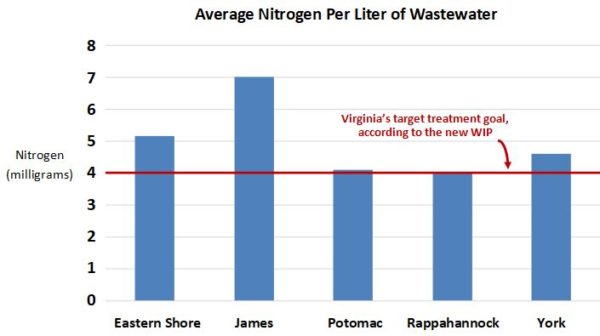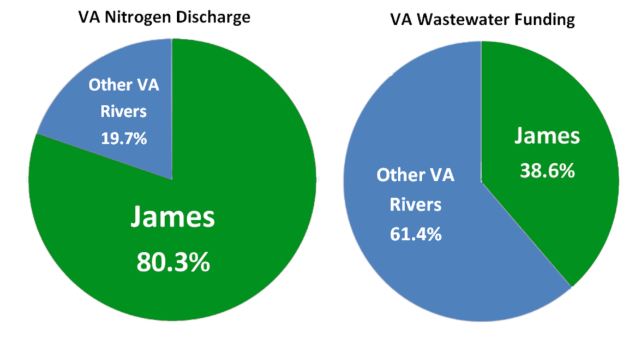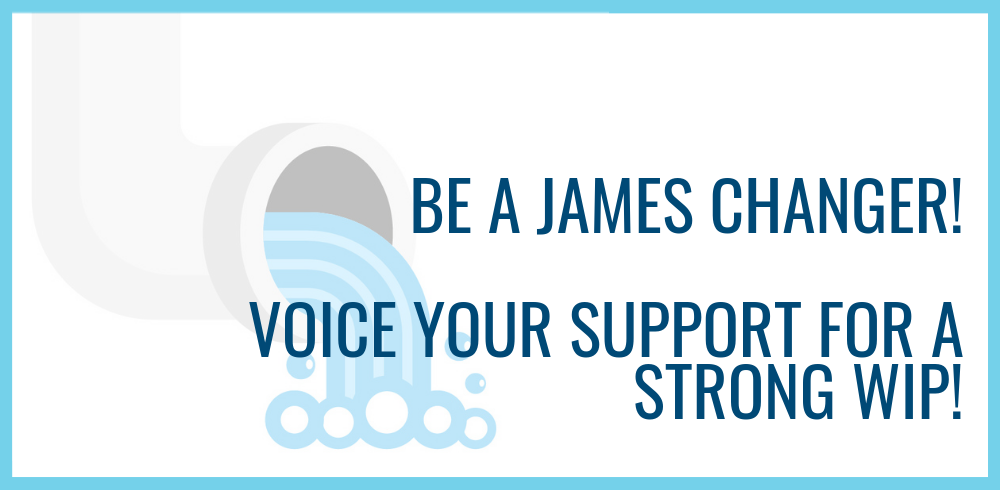Get out your energy domes! This week’s blog is Devo-ted to the James River’s biggest source of nitrogen pollution: wastewater. This issue is hairier than a 1980s rock band, but don’t despair! The draft Watershed Implementation Plan (WIP) gives us an opportunity to tackle wastewater effectively for the James while helping Virginia achieve a clean Chesapeake Bay by 2025!
So what exactly is wastewater? It’s the water that we use to clean our dishes, flush our toilets, and run our businesses and factories. All of our wastewater is supposed to be treated to remove nutrient pollution before it reaches our rivers, but currently, not all wastewater is being treated to the same standard. In fact, for every liter of wastewater released, the James gets hit by nearly twice as much nitrogen pollution as the WIP prescribes (see Figure 1). Many high-tech treatment methods that are used elsewhere in Virginia have not been installed at facilities in the James River watershed, even though we have some of the largest wastewater plants. For more info on treatment facilities near you and across Virginia, check out our new interactive map!

Figure 1: Average nitrogen pollution in wastewater released by treatment plants for Virginia’s major watersheds. (Data from DEQ in 2018).
You might wonder why the James seems so far behind on wastewater. After all, our river still receives more nitrogen pollution from wastewater than from any other source, and we send more nitrogen into the Chesapeake Bay than any other Virginia river. There are two primary factors that slowed us down. First, scientists needed more time and data to tell us how much pollution we needed to cut to keep the James safe from things like harmful algal blooms. After seven years of study, we finally have those answers. Second, we still need more funding. Pollution-reducing technologies can be expensive, so wastewater plants in the James River watershed will need grants from programs like the Water Quality Improvement Fund to help pay for the upgrades. Yet in the past, those grants have gone to other parts of the Commonwealth (see Figure 2).

Figure 1. Nitrogen pollution (left) versus allocated wastewater funding (right) for Virginia rivers within the Chesapeake Bay watershed. Though the James River experiences most of the nitrogen pollution, it has received a much smaller percentage of allocated wastewater funding. (Data provided by DEQ in 2018).
When something’s going wrong – you must WIP it! Virginia has an incredible opportunity ahead, and wastewater treatment upgrades along the James River should be more than just a pipe dream! The draft WIP calls for technology standards that would establish a common bar for wastewater treatment across the Commonwealth. Because the James River receives more wastewater than other Virginia Rivers, the James stands to benefit from pollution reductions like never before. Even better, modernizing more of our wastewater plants would accomplish many different goals at once. Not only would these upgrades reduce nitrogen and phosphorus pollution, but they’ll help to reduce harmful algal blooms, to improve aquatic habitat, and to boost our growing outdoor recreation industry along the banks of the James. In short, securing a new wave of wastewater funding is absolutely critical for a healthy James. And here’s how you can help!
Be a James Changer! Voice your support for a strong WIP. Chances like this don’t come often, and we need to make sure we WIP it good. The new cleanup plan would require additional nutrient reductions from wastewater treatment plants, but the WIP needs public support to turn these plans into action. Your voice can ensure the James gets the attention it deserves!
For more info on what’s coming down the pipe, join our network of volunteers who speak for the James, but don’t stop there!

